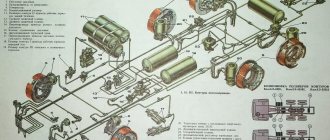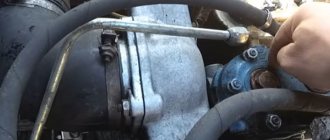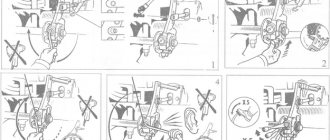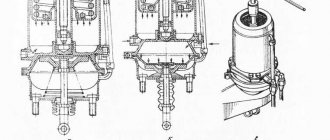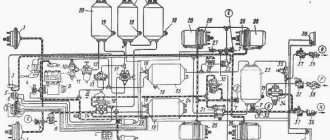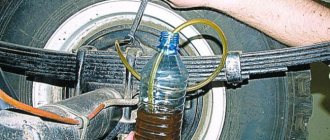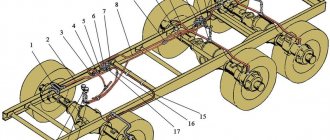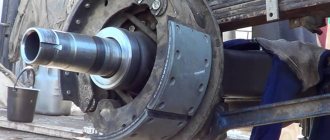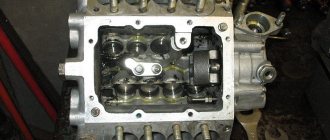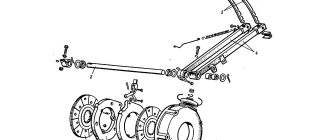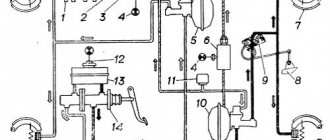Modern KamAZ vehicles use an anti-lock braking system (ABS). This system helps reduce emergency situations when braking. Next, we will talk in more detail about the operation of the system, malfunctions and care to prevent breakdowns of the braking control system. Here you will get answers to all your questions. Read further:
- Electronic control system components
- The principle of operation of ABS on KamAZ
- Malfunctions of the ABS brake control system
- Tips for preventing and repairing breakdowns
- Advantages of a KamAZ truck with ABS system
Design and principle of operation
Truck ABS includes the following elements:
- wheel speed sensors;
- modulators that regulate air pressure in the brake chambers;
- solenoid valve that turns off the auxiliary brake;
- electronic control unit (ECU);
- fuse box;
- relays, connecting wires and alarm lamps.
The operating principle of the system is based on measuring and comparing wheel speed and generating a command to control the brake elements based on signals from the ECU. The output signal is generated in the event of data on different wheel speeds and affects the modulators, which ensures stability and controllability of the truck during braking.
Scheme
Most often, KamAZ uses an ABS scheme built on the principle of 4 sensors and 4 modulators. This makes it possible to act on the braking elements of all wheels. The rear bogie modulators control the wheel brakes on one side of the middle and rear axles. At the same time, they increase and maintain pressure in the brake chambers, and, if necessary, release it.
When one front wheel is locked, the system changes the pressure in the front brake chamber of the other in steps. During braking mode, the engine brake is activated. When skidding, it is disabled, but if the solenoid valve wire breaks, it can negatively affect both the operation of the ABS and the braking mode.
How to install
Installation of ABS on KamAZ is carried out only in specialized workshops that have permission for this type of activity. Independent intervention in the design of the brake system is strictly prohibited.
How to disable
The easiest way to disable the anti-lock braking system is to remove the fuses or disconnect the sensor connectors. However, this is not recommended due to the fact that a functioning system reduces the braking distance and prevents the car from skidding.
Location of ABS components
4.2 Location of ABS components.
ABS - 4S/2K - the speed is measured on each wheel, controlled by two modulators, one for each axis (shown in Figure 13).
Figure 13. Location of ABS components -4S/2K
Legend: 1. Electronic control unit; 2. Speed sensor; 3. ABS modulator; 4. ABS warning lamp; 5. PBS indicator lamp; 6. PBS brake control valve; VL - front left wheel, VR - front right wheel, HL - rear left wheel, HL - rear right wheel, BBA, Vorrat pressure supply (air, liquid).
ABS - 4S/3K - speed is measured on each wheel, controlled by three modulators, two modulators on the front axle and one on the rear (shown in Figure 14).
4.2. Location of ABS components
Figure 14. Location of ABS components -4S/3K
ABS - 4S/3K - speed is measured on each wheel, controlled by 3 modulators, one modulator on the front axle and two on the rear (shown in Figure 15).
Figure 15. Location of ABS components -4S/3K
ABS - 4S/4K - speed is measured on each wheel, control is carried out by 4 modulators independently of each other (shown in Figure 16).
Figure 16. Location of ABS components - 4S/4K
4.3. General layout of ABS and PBS components
The general diagram is shown in Figure 17. The graphical designation of the components is shown in Appendix 36.
Figure 17. General layout of components
Designations: 1. Toothed ring; 2. Speed sensor; 3. Electronic control unit; 4. ABS modulator; 5. ABS warning lamp; 6. PBS brake control valve; 7. Engine control valve PBS; 8. Speed limiting system actuator cylinder; 9. PBS indicator lamp; 10. Double-line valve; 11. Accelerator pedal; 12. Vehicle fuel injection pump. VVA - pressure supply (air, liquid)
Source
Purpose of the anti-lock braking system
ABS is installed on many KamAZ models for better control of the braking system (on such trucks it is pneumatic). KamAZ trucks have different types of braking: service, parking, spare, auxiliary braking, emergency brake release. The anti-lock braking system prevents the wheels from locking when braking, which improves controllability, avoids skidding, and stopping the car becomes smoother. Also, the presence of ABS is important to increase the average safe speed at different clutches.
Brake systems
The brake mechanisms are a drum type system with two internal pads, the diameter of the brake drums is 420 mm, the width of the linings is 180 mm. The front brake chambers are diaphragm type 30, the rear ones are type 30/24.
Drive of service brake systems
- pneumatic, separate. Number of receivers 6, total volume 120 liters.
Nominal pressure in the pneumatic drive (6.5-8.0 kgf/cm2).
Compressed air pressure
in the pneumatic drive, adjust screw 2 of the pressure regulator (see Fig. Pressure regulator). When the screw is screwed in, the amount of adjustable pressure increases, and when turned out, it decreases.
in the vehicle's brake system (see Fig. Pressure regulator). The dryer is designed in conjunction with a pressure regulator and is designed for cooling, releasing condensate and maintaining the required pressure of compressed air supplied from the compressor. The compressed air supplied from the compressor to the dryer passes through the felt disc and granulate, is cleaned and goes further into the brake system. After the brake system is filled and the pressure regulator is activated, the granulate is cleaned of moisture by air escaping into the atmosphere through the atmospheric outlet of the dryer. Maintenance of the dryer consists of periodically replacing the filter element as it becomes dirty (about once every two years).
For inflating tires
The pressure regulator has an air bleed valve, closed with cap 1 (see Fig. Pressure regulator). When bleeding air with a hose for inflating tires from the tool kit, connect it instead of the cap, screwing the wing nut all the way, and reduce the compressed air pressure in the pneumatic drive, because when the compressor is idling, there is no air bleed. To reduce pressure, open the condensate drain valve on any receiver. Drain the condensate from the receivers daily after finishing work. The compressed air pressure in the pneumatic drive must be nominal.
Open the condensate drain taps by moving the pusher aside by the ring (see figure). Do not pull the stem down or push it up. After draining the condensate, bring the compressed air pressure in the pneumatic drive to nominal.
working
brake systems are controlled by a two-section valve driven by a pedal.
Adjust the position of the brake pedal relative to the cabin floor according to the diagram for installing the pedal on the brake valve. By adjusting the installation and adjusting bolts, it is necessary to ensure that the pedal platform is positioned at an angle of 35° ± 2° and the free play of the pedal is 10-15 mm. Secure the installation bolt with a lock nut, cover the adjusting bolt with UG7 sealant before adjustment.
The design of the pneumatic drive of the vehicle's brake mechanisms provides for the possibility of emergency release of the brakes when the handle of the control valve for the parking and spare brake systems , regardless of the degree of filling of the receivers with air. This makes it possible to start driving after the parking brake warning light goes out. It should be remembered that if there is no air in the receivers (pressure gauge readings), the service brake system does not operate and braking must be carried out using a manual brake valve. In addition, if there is no compressed air in the pneumatic system, the car can be released using the screws of the emergency brake release mechanism, which are built into the cylinders of spring energy accumulators.
Features of control of KamAZ vehicles equipped with ABS
Drivers driving a car with ABS mistakenly believe that such a system can improve traction, but this is not the case. Due to the fact that the wheels do not lock, controllability is increased and situations where the trajectory of movement can change sharply are prevented.
ABS can eliminate some potentially dangerous moments during braking and reduces the braking distance, but in general, vehicle control remains the same as without an anti-lock braking system.
Almost the only rule of operation is the prohibition of using intermittent braking: the brake pedal must be pressed as hard as possible, all the way. Otherwise, the operation of the ABS may become incorrect and the motion sensors will not respond properly.
Types of ABS
Different KAMAZ models use German (Wabco, Knorr Bremze) and Belarusian “Ekran” anti-lock braking systems.
- single-channel – release of the brakes on all wheels when one is blocked
- two-channel – axis adjustment using a low-threshold or high-threshold wheel
- three-channel – the rear wheels are controlled from this channel, the front wheels are controlled from individual
- four-channel – each wheel is controlled via its own channel
Malfunctions and repairs
ABS has a built-in self-diagnosis function. It is turned on by turning the ignition switch to position “I”. In this mode, the functionality of sensors, blocks, connections and system elements is checked. The signal is removed when the car reaches a speed of 7-10 km/h. If it continues to light, then the test is carried out in the forced ABS diagnostic mode.
Error codes
If an inoperative element appears, the warning lamp lights up and the system generates error codes. The defective element is determined by the number of flashes of the indicator. In the forced diagnostic mode, the ECU first displays the last 4 errors that remain in the device’s memory once. The meaning of the code is determined using special tables. For example, the resulting value 2-1 corresponds to a malfunction of modulator B, characterized by a short to ground. The codes remain in the ECU memory.
| First error code | Second error code | Troubleshooting Methods |
| 1 - No mistakes | 1 - No mistakes | The system is fully operational |
| 2 – ABS modulator | 1 – Front right 2 – Front left 3 – Rear right 4 – Rear left | Check the wires to the modulator. There is an intermittent or permanent break in the wires to the intake, exhaust valves or the “common” wire, or a short to negative. |
| 3 – Sensor: increased air gap | 1 – Front right 2 – Front left 3 – Rear right 4 – Rear left | Check wheel bearing runout. Move the sensor towards the rotor. Check the sensor cable and connectors for loose contacts. |
| 4 – Sensor: short circuit/wire break | 1 – Front right 2 – Front left 3 – Rear right 4 – Rear left | Check the wires to the sensor. Open or short to “minus” or “plus” or between the sensor wires. |
| 5 – Lost signal / tire size | 1 – Front right 2 – Front left 3 – Rear right 4 – Rear left | Check the wires to the sensor for loose contact. Check the rotor for damage. Connect another sensor to check. Wheel diameters vary. |
| 6 – Rotor | 1 – Front right 2 – Front left 3 – Rear right 4 – Rear left | Check the rotor for damage. Replace the rotor. |
| 7 – System functions | 4 – ABS lamp | Check the wires for the ABS fault warning light. Was the ABS diagnostic switch pressed for more than 16 seconds? |
| 8 - The electronic unit | 1 – Reduced supply voltage | Check the power circuits and ABS fuses. Reduced supply voltage |
| 8 - The electronic unit | 2 – Increased supply voltage | Check the battery and alternator. Increased supply voltage |
| 8 – The electronic unit | 3 - Internal error | Replace the ABS control unit if the error recurs |
| 8 - The electronic unit | 4 – Configuration error | Incorrect electronics / parameterization |
| 8 - The electronic unit | 5 – Connection to the battery negative | Check the ground on the ABS control unit and modulators. |
Diagnostics and repair of ABS (ABS) Kamaz
ABS system - what is it, what advantages does KAMAZ ABS have, what problems arise with this system and how to solve them?
ABS - general concept
ABS is an anti-lock braking system that prevents the wheels from locking when the brakes are applied suddenly. What happens to the wheels when you press the brakes? The wheel spins on a certain disk and when you press the brake, this disk is pressed on both sides by the brake pads. The harder you press the brake, the more pressure occurs. If the pressure on the brake is extremely sharp, then the wheels are blocked. The car continues to move, but the wheels are already blocked. If at this moment an emergency situation arises and you need to sharply turn the steering wheel of the car, then an emergency situation will arise. After all, it will be impossible to turn the car around. The anti-lock braking system does not allow the wheels to lock, no matter how hard you press the brakes.
KAMAZ with ABS system: advantages and types
The brake systems of KAMAZ vehicles also use the ABS technical braking system, which increases the efficiency and safety of truck driving. KAMAZ vehicles have several types of braking: parking; working; spare; auxiliary; emergency release.
Thanks to this system, the driver has full control of the car. What advantages does the ABS system give to KAMAZ trucks: when braking, the truck is prevented from skidding; braking distance decreases; the truck's controllability when braking increases; You can drive the car even in the most severe weather conditions and on poor-quality roads. The braking efficiency of the car increases. Tire life is extended. active safety is increased by ensuring controllability and stability. The load on the clutch mechanisms is reduced.
Thanks to this braking system, it was possible to prevent many car accidents and save lives. But in order for the system to work correctly, you need to press the brake pedal firmly all the way.
There are several types of ABS systems:
- single-channel: when one wheel is blocked, all are released;
- two-channel: the axis is adjusted according to a high-threshold wheel or a low-threshold one.
- three-channel: the rear wheels are controlled from one channel, and the front wheels from individual channels;
- four-channel: each wheel is controlled via its own channel.
KAMAZ models use Belarusian and German “Ekran” anti-lock braking systems.
Anti-lock braking system malfunctions
The system has a built-in self-diagnostic function. When the lock is turned, this function is turned on and the functionality of sensors, connections, blocks and system elements is automatically checked. As soon as the car reaches a speed of 7-10 km/h, the signal turns off. If the signal does not turn off and continues to light, then the test is already carried out in the forced ABS diagnostic mode.
There is an icon on the dashboard of the car that indicates a malfunction in the anti-lock braking system of the car. What are the types of ABS malfunctions: Wheel sensors fail. The elements become dirty because they are located close to the moving parts of the hub. Frequent malfunctions of the ABS occur precisely because of this. Sensors are very vulnerable. Disturbances occur in electrical contact. This malfunction is indicated by a flashing control light. Sudden changes in voltage at the battery terminals.
How can you avoid these problems?
The latter problem can be avoided if the batteries are used correctly. And in other cases: it is impossible to disconnect and connect the connectors while the motor is on; Do not overuse cigarettes; It is not recommended to dry the car using the hot method. The ABS control unit should not heat up more than 85 degrees Celsius. If welding work is carried out from the control unit, you need to turn off the power supply.
Of course, you can use these tips, but if you have such a problem, then it is impossible to do without the help of professionals. After all, malfunctions of the KAMAZ anti-lock braking system can be different and the causes are different; you yourself cannot determine the error codes. What to do, who to contact for diagnostics and repair of KAMAZ ABS in the cities of Surgut and Nizhnevartovsk?
engaged in the sale and service of KAMAZ vehicles in the Tyumen region. The company's main office is located in Surgut, and branches are located in Tobolsk, Orenburg, Nizhnevartovsk and Nefteyugansk.
Why can you be sure that it is worth contacting this company for diagnostics and repair of KAMAZ ABS?
The company has the largest warehouse selling original spare parts for all KAMAZ models. Offers service, technical and warranty services, repairs all brands of trucks, special equipment, tractors, etc. The company has all the necessary certificates that prove many years of experience and quality of work. All these benefits show that you can confidently contact the company knowing that your problem will be solved. Professionals will diagnose your truck, identify the cause of the problem and repair it. Everything will be done at a high level.
Diagnostics and repair of ABS KAMAZ
How are problems and malfunctions detected in the anti-lock braking system? What is the first signal that individual parts and the entire system are not working correctly? The ABS light comes on. If there are no malfunctions or breakdowns in the system, then the light should light up when the truck starts and after a few seconds it should go out. This short period is a test of the performance of the anti-lock braking system. Signals are sent to the car sensors, and response impulses come from them. If the light comes on and does not go out while driving, this may reveal the following problems: one of the wheels has a problem communicating with some sensor; there may be damage in the control unit; all sensors fail; There is poor contact in the connecting cables. Wires break while driving, also on a bad road or during strong vibrations. The connections in the connectors become loose and breakage occurs. This is how the first problems and malfunctions in the system are identified.
Problems with the control unit are the most difficult. To identify these faults, specialists use the on-board computer. Thanks to this, you can see the system error code. Using these methods, problems in the anti-lock braking system are calculated.
As you can see, it’s not worth solving the issue yourself, since diagnosing and repairing the ABS system is a complex process and you need to have professional diagnostic equipment at hand and have special knowledge and skills. After all, only highly qualified specialists can competently identify faults and repair them using high-quality and necessary spare parts.
All this knowledge and skills are possessed by specialists. If you have a problem with the KAMAZ anti-lock braking system, then call the indicated phone numbers right now, fill out a feedback request and order a service for your truck.
How to avoid breakdown
Like any other important component of a truck, ABS requires timely diagnostics. It can be done using a special program that shows how this or that part of the system works.
ABS does not require special maintenance; it is checked during scheduled maintenance of the brake system. What should be the preventative measures to help prevent breakdowns? Do not use impulsive braking, especially on slippery roads. Also, the brake pedal should be pressed quite firmly, but without a sharp jerk.
KAMAZ 65115 air system diagram
Pneumatic braking system
How the WABCO ABS pneumatic braking system works
KAMAZ brake system
Air leak from the brake valve KAMAZ ZIL PAZ MAZ KRAZ GAZ
Brake pipe sealing coupling
How to remove the main brake valve on a Kamaz 5511 car
Fuel and air pipes standard for KAMAZ, MAZ, Tractor...
How does an air brake system work?
Everyday life of Kamazist: Elimination of air leaks, repairs
64221-3537310-20
Also see:
- How to lighten KAMAZ 6520
- How to insulate a KAMAZ engine
- Blink code for KAMAZ
- Fittings for the KAMAZ brake system
- Drive for KAMAZ parameters
- Gearbox lever KAMAZ 4308
- Oil poured into KAMAZ gearbox
- Collision between KAMAZ and a passenger car
- King pin KAMAZ 53212
- KAMAZ Euro 2 engine models
- Gas-cylinder vehicles KAMAZ
- Kruse and KAMAZ accident
- Rear part of the KAMAZ front fender
- Camera r21 KAMAZ
- Volume of liquids of a KAMAZ vehicle
Home » Video » Diagram of the air system of KAMAZ 65115
kamaz136.ru
How much does repair and replacement cost?
Depending on which part of the ABS is broken, the price of the repair service will differ. If an ABS unit breaks down, it can be repaired in Moscow at a cost of 5 thousand rubles. Replacing a unit costs from 4,000, and replacing each sensor will cost from 800 rubles. Repair of camshaft and crankshaft sensors will be more expensive - from 1,300 rubles.
Defects in the operation of sensors can be eliminated without replacement - the cost of repairs starts from 1,300 rubles. The cost of repairs includes diagnostics and installation; in case of replacement, these parameters are discussed separately.
Have you used a KamAZ with ABS? Do you consider such an innovation necessary?
Source
